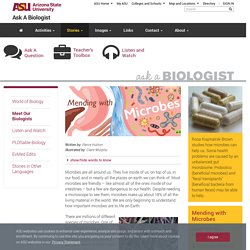

(90) How the food you eat affects your gut - Shilpa Ravella. The Human Ecosystem. The Invisible Universe Of The Human Microbiome. Can Poop Cure an Infection? (87) How do germs spread (and why do they make us sick)? - Yannay Khaikin and Nicole Mideo. How Far Do Sneezes and Vomit Travel? You Are Mainly Microbe - Meet Your Microbiome. Face Mites: They Really Grow On You : Shots - Health News : NPR. What's up with Your Gut Microbiome? (87) What causes antibiotic resistance? - Kevin Wu. You Almost Certainly Have Mites On Your Face.
Think of all the adults you know.

Think of your parents and grandparents. Think of the teachers you had at school, your doctors and dentists, the people who collect your rubbish, and the actors you see on TV. All of these people probably have little mites crawling, eating, sleeping, and having sex on their faces. There are more than 48,000 species of mites. As far as we know, exactly two of those live on human faces. They live in our hair follicles, buried head-down, eating the oils we secrete, hooking up with each other near the surface, and occasionally crawling about the skin at night.
As I wrote back in 2012, the mites were discovered in 1841, but only properly described a year later by German dermatologist Gustav Simon. Scientists have since found Demodex in every ethnic group where they’ve have cared to look, from white Europeans to Australian aborigines to Devon Island Eskimos. But it’s always been hard to say exactly how common they are. So Thoemmes did something different. Evolutionary Medicine. Dr.

Biology: This is Ask A Biologist, a program about the living world and I'm Doctor Biology. You probably don't know it, but I just got over having a cold, so if my voice sounds a little bit different, that's probably why. If you describe it, it's the typical sneezy, runny nose and coughing type of cold. And while I say typical, well even cold viruses, there are a whole bunch of them - at least 150 different types. Just ask my wife who was getting over a cold when I got back with this particular cold virus while I was away on a trip and so one cold is bad enough, but in her case she got two colds in a row, which brings me to the topic of today's show getting sick and why do we get sick?
My guest today is Randy Nessie, a physician and Foundation professor in the ASU School of Life Sciences. Randy: Great to be here. Dr. Randy: You know, before we talk about why we get sick, we should just all be amazed that we don't get sick most of the time. Good microbes Inside and outside of the body. Dr.

Biology: This is Ask A Biologist, a program about the living world, and I'm Dr. Biology. Dr. Biology: If you do much reading or watched much television lately, you know that bacteria have a really bad reputation. Just about everything you hear about these tiny organisms has them causing all sorts of problems. Environmental Engineer. Microbes are all around us.

They live inside of us, on top of us, in our food, and in nearly all the places on earth we can think of. Most microbes are friendly – like almost all of the ones inside of our intestines – but a few are dangerous to our health. Despite needing a microscope to see them, microbes make up about 18% of all the living material in the world.
We are only beginning to understand how important microbes are to life on Earth. Microbes are everywhere, in all different shapes and sizes. There are millions of different species of microbes. Try to imagine all of the microbes on your skin right now. Microbes to the Rescue Why might it be good to know what microbes are hanging around? Chemical spills can be extremely damaging to the environment, and are very difficult and expensive to clean up. Krajmalnik-Brown has studied how to use microbes to clean up spills of many types of chemicals, such as oil and chemical compounds that contain chlorine. The Microbiome: Good and Bad.